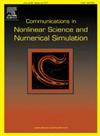Finite-time stability of 2D continuous switched nonlinear systems
IF 3.8
2区 数学
Q1 MATHEMATICS, APPLIED
Communications in Nonlinear Science and Numerical Simulation
Pub Date : 2025-09-19
DOI:10.1016/j.cnsns.2025.109340
引用次数: 0
Abstract
The finite-time stability theory of 2D switched linear systems has been well developed, whereas few studies have focused on 2D switched nonlinear systems. In this paper, the finite-time stability of 2D continuous switched nonlinear systems is discussed. Firstly, by employing a common Lyapunov function method, the upper bounds on the times and required for the system to achieve finite-time stability are obtained. The results indicate that these upper bounds mainly depend on the system parameters and are independent of the switching signals. Sufficient conditions for the finite-time stability of 2D continuous switched nonlinear systems are further derived. Secondly, considering a wider range of situations, we introduce the multiple Lyapunov function methods, and derive the upper bounds on the times and again. The results reveal that, in addition to the system parameters, the upper bounds on the times and are also influenced by the switching signals. Additionally, a finite-time stabilization strategy is proposed based on the average dwell time method. We also extend the conclusions of finite-time stability to 2D continuous switched linear systems. Finally, two numerical examples are provided to illustrate the validity of our results.
二维连续切换非线性系统的有限时间稳定性
二维切换线性系统的有限时间稳定性理论已经得到了很好的发展,而对二维切换非线性系统的研究却很少。本文讨论了二维连续切换非线性系统的有限时间稳定性问题。首先,采用常用的Lyapunov函数方法,得到了系统达到有限时间稳定所需的T1和T2的上界。结果表明,这些上界主要取决于系统参数,与开关信号无关。进一步推导了二维连续切换非线性系统有限时间稳定性的充分条件。其次,考虑到更广泛的情况,我们引入了多重Lyapunov函数方法,并再次导出了T1和T2的上界。结果表明,除系统参数外,T1和T2的上界也受开关信号的影响。此外,提出了一种基于平均停留时间法的有限时间稳定策略。我们还将有限时间稳定性的结论推广到二维连续切换线性系统。最后,给出了两个数值算例来说明结果的有效性。
本文章由计算机程序翻译,如有差异,请以英文原文为准。
求助全文
约1分钟内获得全文
求助全文
来源期刊

Communications in Nonlinear Science and Numerical Simulation
MATHEMATICS, APPLIED-MATHEMATICS, INTERDISCIPLINARY APPLICATIONS
CiteScore
6.80
自引率
7.70%
发文量
378
审稿时长
78 days
期刊介绍:
The journal publishes original research findings on experimental observation, mathematical modeling, theoretical analysis and numerical simulation, for more accurate description, better prediction or novel application, of nonlinear phenomena in science and engineering. It offers a venue for researchers to make rapid exchange of ideas and techniques in nonlinear science and complexity.
The submission of manuscripts with cross-disciplinary approaches in nonlinear science and complexity is particularly encouraged.
Topics of interest:
Nonlinear differential or delay equations, Lie group analysis and asymptotic methods, Discontinuous systems, Fractals, Fractional calculus and dynamics, Nonlinear effects in quantum mechanics, Nonlinear stochastic processes, Experimental nonlinear science, Time-series and signal analysis, Computational methods and simulations in nonlinear science and engineering, Control of dynamical systems, Synchronization, Lyapunov analysis, High-dimensional chaos and turbulence, Chaos in Hamiltonian systems, Integrable systems and solitons, Collective behavior in many-body systems, Biological physics and networks, Nonlinear mechanical systems, Complex systems and complexity.
No length limitation for contributions is set, but only concisely written manuscripts are published. Brief papers are published on the basis of Rapid Communications. Discussions of previously published papers are welcome.
 求助内容:
求助内容: 应助结果提醒方式:
应助结果提醒方式:


